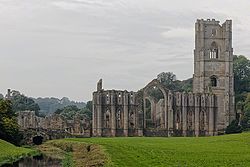Fountains Abbey
| Fountains Abbey and Studley Royal Water Garden | |
|---|---|

Fountains Cistercian Abbey: River Skell, Tower & Chapel of Altars
|
|
| Location | Near Aldfield, North Yorkshire, England |
| Coordinates | 54°6′35″N 1°34′53″W / 54.10972°N 1.58139°WCoordinates: 54°6′35″N 1°34′53″W / 54.10972°N 1.58139°W |
| Built | 1132 |
| Governing body | National Trust |
| Official name: Studley Royal Park including the Ruins of Fountains Abbey | |
| Type | Cultural |
| Criteria | i, iv |
| Designated | 1986 (10th session) |
| Reference no. | 372 |
| Country | United Kingdom |
| Region | Europe and North America |
|
Listed Building – Grade I
|
|
| Official name: Fountains Abbey, with Ancillary Buildings | |
| Designated | 11 June 1986 |
| Reference no. | 1149811 |
Fountains Abbey is one of the largest and best preserved ruined Cistercian monasteries in England. It is located approximately 3 miles (5 kilometres) south-west of Ripon in North Yorkshire, near to the village of Aldfield. Founded in 1132, the abbey operated for over 400 years, until 1539, when Henry VIII ordered the Dissolution of the Monasteries.
The abbey is a Grade I listed building owned by the National Trust and part of the designated Studley Royal Park including the Ruins of Fountains Abbey UNESCO World Heritage Site.
After a dispute and riot in 1132 at the Benedictine house of St Mary's Abbey, in York, 13 monks were expelled (among them Saint Robert of Newminster) and, after unsuccessfully attempting to return to the early 6th-century Rule of St Benedict, were taken into the protection of Thurstan, Archbishop of York. He provided them with land in the valley of the River Skell, a tributary of the Ure. The enclosed valley had all the natural features needed for the creation of a monastery, providing shelter from the weather, stone and timber for building, and a supply of running water. After enduring a harsh winter in 1133, the monks applied to join the Cistercian order and in 1135 became the second house of that order in northern England, after Rievaulx. The monks subjected themselves to Clairvaux Abbey, in Burgundy which was under the rule of St Bernard. Under the guidance of Geoffrey of Ainai, a monk sent from Clairvaux, the group learned how to celebrate the seven Canonical Hours and were shown how to construct wooden buildings in accordance with Cistercian practice.
...
Wikipedia

